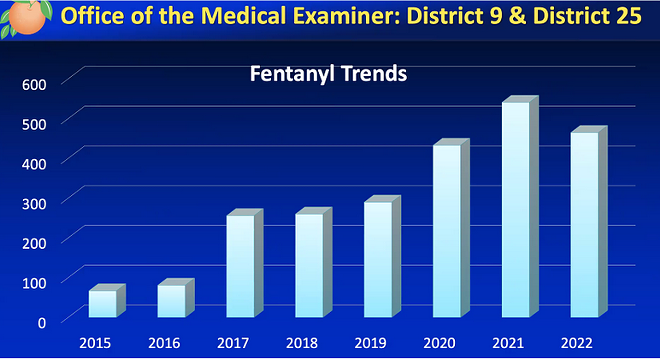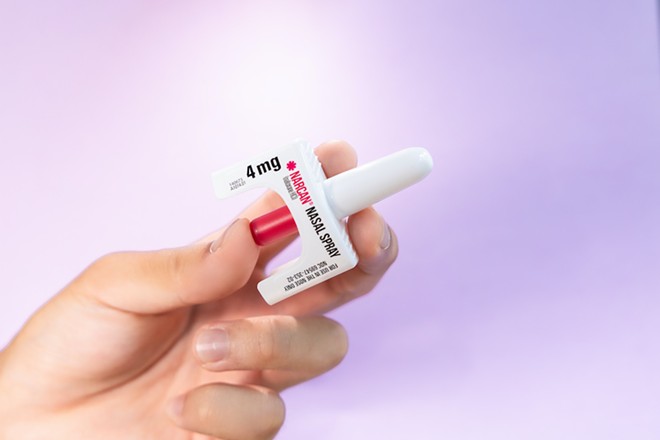Adobe
Experts say that expanding access to naloxone, including Narcan nasal spray products, is an important component of drug overdose prevention.
Opioid-related overdose deaths in Orange County decreased last year for the first time in years, according to county data, but there’s still a lack of awareness in the community about available resources, support, and what to do in the event of an overdose.
Dr. Thomas Hall, director of Orange County’s Coalition for a Drug-Free Community, shared during a virtual discussion hosted by Orlando’s State Rep. Anna Eskamani that overdose deaths involving opioids — particularly the powerful opioid fentanyl — decreased 14% in 2022.
From January to September 2022, there were 342 fatal drug overdoses in Orange County, according to the Medical Examiner’s Office. Over 70% of those deaths involved fentanyl, a potent painkiller that’s 50 times stronger than heroin.
According to Dr. Hall, who has 30 years of professional experience in the mental health and substance use treatment space, fentanyl-related deaths have increased dramatically since 2018, while deaths involving heroin have decreased.

Dr. Thomas Hall/Orange County Coalition for a Drug-Free Community
Data from the Orange County government demonstrates a rise in fentanyl-related deaths.
A major contributing factor to that trend, which extends nationally, is the proliferation of illicitly manufactured fentanyl.
Illicit forms of fentanyl, which is legally prescribed to treat chronic pain, is commonly laced into non-opioid drugs sold on the street, such as cocaine or meth. It’s also falsely marketed in pill form as something else, or laced into counterfeit versions of drugs like Xanax.
One of the issues with fentanyl, according to Hall, is that it’s easy to make, it’s inexpensive, and it’s easy to transport. “So I don’t think that it’s going to go away anytime soon,” he said.
But he, and other experts in Orange County who are tracking local overdose data, are hopeful in the face of last year’s drop in overdose deaths, disrupting a years-long trend in the opposite direction.
In 2020, during the first year of the pandemic, overdose deaths increased 23% in Orange County — as they rose throughout the rest of the U.S. — and then rose another 20% the following year.
“Hopefully we’ve hit the ceiling,” said Hall, who oversees the Orange County Health Services Department Substance Abuse Prevention, Treatment and Recovery initiatives.
Isolation during the pandemic, a disruption to one’s social support system, and other risk factors for substance use and relapse during COVID-19, such as increased stress and anxiety, placed people with a history of drug misuse at a greater risk for overdose, according to experts.
The decline in overdose deaths in Orange County is “promising,” said Hall, but he also understands that for those who have already lost someone, this is of limited comfort.
“I deal with a lot of families who’ve lost loved ones, and so those trends are little solace to someone who’s lost a mother, father, brother, sister, or son or daughter,” he said.
Between 2014 and 2019, opioid-related overdose deaths in Orange County nearly doubled — from 175 to 342.
Nationwide, drug overdose deaths reached a staggering record high of 110,236 from March 2021 to March 2022, galvanizing both a federal response and a local response to the crisis at hand.
Hall shared that the county’s targeted “One Pill Can Kill” messaging, through advertisements on Lynx buses and video ads at gas stations, is one factor his team believes has helped lead to the recent decline in fatal overdoses.
The ads highlight the dangers of illicit fentanyl use, as well as explaining where to find naloxone, a medication that can save lives in the event of an opioid overdose.
According to law enforcement officials and treatment providers, more people are also adopting harm reduction practices on their own to help prevent fatal overdose and increase safety, Hall said.
One example is using drugs only in the presence of another person, and not using alone.
“We’re seeing more and more people use the buddy system when they’re using, particularly opioids,” said Hall. “So one person will have Narcan [brand name for naloxone] and the other person who’s using will rely on their buddy to save them if they have an overdose.”
Common signs of an opioid overdose include slowed or stopped breathing, unconsciousness or unresponsiveness, tiny pupil size, weak pulse, and bluish, pale or ashen skin color.
And when it comes to fentanyl overdose, time is of the essence in seeking medical help or administering naloxone, either in its injectable form or nasal spray.
Nationally, the Biden administration has moved forward with an overdose prevention strategy that involves the expansion of evidence-based treatment for substance misuse, disrupting drug trafficking, prevention programs, and the promotion of harm reduction initiatives, like expanding access to naloxone and fentanyl test strips.
Earlier this month, Florida legislators unanimously approved legislation that will decriminalize fentanyl test strips, which has long been officially classified as illegal “drug paraphernalia” under state statutes. That bill is yet to be signed into law by Gov. Ron DeSantis.
Some critics of harm reduction initiatives say that harm reduction can promote or condone substance use.
But advocates include federal agencies like the Substance Abuse and Mental Health Services Administration, which now supports a harm reduction approach. Those advocates say it can help save lives and reduce the harm posed to people who use drugs, regardless of whether they are actively seeking or in treatment at that time.
The long and short of it, Hall shared, is that “dead people never recover.”
Finding solutions locally to prevent future tragedy
The county’s current strategies for comprehensive overdose prevention include expanding awareness of treatment options, expanding naloxone access for first responders and the general public, and doing more educational outreach, to increase awareness of the dangers of fentanyl use and how to administer naloxone if someone is overdosing.
“We have to get the word out that, you know, there are people who administer Narcan and kind of normalize it,” said Hall.
Many people, he added, aren’t aware of Florida’s 911 Good Samaritan law, passed by state legislators in 2012.
That law says that “a person acting in good faith who seeks medical assistance for an alcohol- or drug-related overdose may not be arrested, charged, prosecuted, or penalized for simple drug possession,” according to information shared by the county.
Florida’s Good Samaritan law, like similar policies across the country, is meant to reassure people who might otherwise be worried about calling 911, even in a life-and-death situation, out of concern that they’ll face charges or be made liable for someone’s overdose themselves.
Using funds from federal grants, the county as it is has created public safety announcements, and is boosting efforts to educate community stakeholders — from businesses, to public employers, to faith leaders and community organizations — on signs of overdose and how to administer naloxone in the event of an overdose.
“I spent a morning at one of our churches in Parramore distributing Narcan and information on how to use Narcan as well as other community resources,” said Hall. “So we are happy to do that on Sunday mornings, Wednesday evenings — you name it, we’ll be there.”
But, Hall acknowledges that fully tackling the overdose crisis requires a comprehensive approach that goes beyond prevention: ensuring folks have access to stable, affordable housing with supportive services. Expanding access to effective treatments, particularly on an outpatient level.
“If all we have is treatment, residential treatment, people cycle in, cycle out,” Hall shared. “They get treatment, they get out, they’ve got nowhere to live, they relapse.”
Relapse rates for substance use disorders are high, especially if someone lacks access to effective treatments and other supports, such as stable housing, reliable transportation, a supportive family and treatment for co-occurring mental health issues.
The most effective treatment for opioid use disorder in particular is medication-assisted treatment, a combination of behavioral therapy and medication that can help with drug cravings and relieve withdrawal symptoms.
Access to medication-assisted treatment, however, has historically been more difficult in rural communities, where treatment providers are few and far between. And if you’re uninsured, or underinsured, it can come at an unaffordable cost.
Even more, some recovery housing and shelters for people who are homeless (a risk factor for substance misuse, and vice versa) prohibit the use of any drug, even medication that’s taken as part of a treatment plan for addiction.
So, there are some barriers that have yet to be overcome. At this time, education is considered a key component of the county’s strategy to reach not just those who have a clinical substance use problem, but anyone who buys drugs through the illicit drug market.
Hall’s team is looking to recruit “influencers” or brand ambassadors of sorts who are willing to share their personal stories and help educate the community on what to do if someone has overdosed.
Where to find help
If you or a loved one is struggling with a drug or alcohol problem, the best way to find treatment is through the Substance Abuse and Mental Health Services Administration.
You can access SAMHSA’s treatment locator online, or call their National Helpline at 1-800-662-HELP (4357).
To find naloxone, visit isavefl.com, or access free naloxone at Orange County Department of Health locations listed here.
The Orange County government also has a list of treatment resources, including social services, on its website.
Subscribe to Orlando Weekly newsletters.
Follow us: Google News | NewsBreak | Reddit | Instagram | Facebook | Twitter

